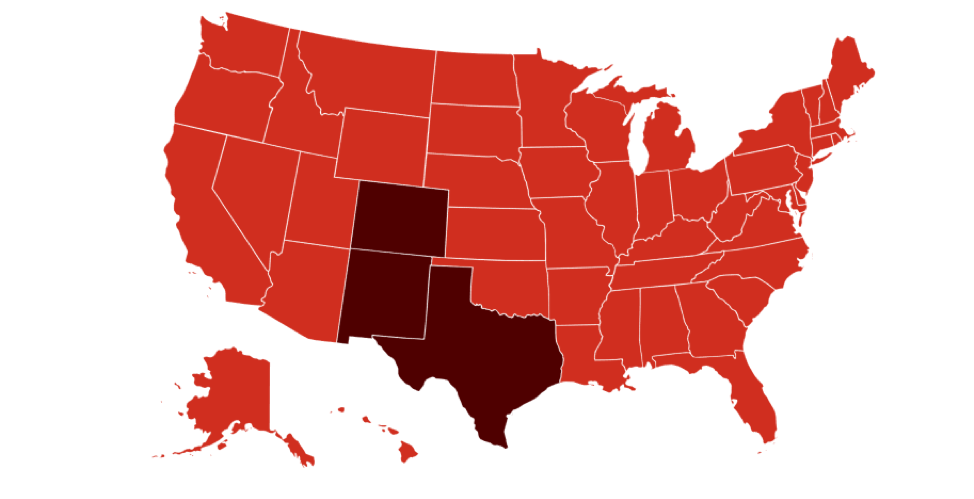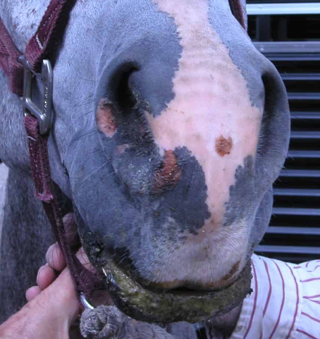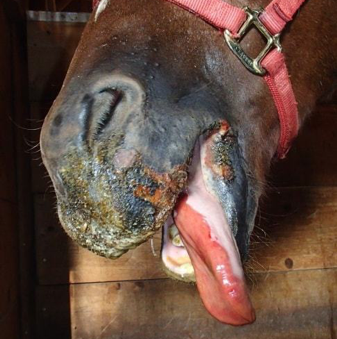
July 2019
Vesicular Stomatitis (VS): Outbreak Mitigation
By Dr. Caitlin Moreno, Intern, Equine Medicine and Surgery
What is Vesicular Stomatitis?
Vesicular Stomatitis is a viral disease characterized by blister-like lesions found around the nose, lips, tongue, gums, teats, sheath, or coronary bands. The disease most commonly affects horses and cattle, but can affect sheep, goats, swine, and camelids. Although rare, the disease can be transmitted to humans that are exposed to the virus when handling infected animals.
Which locations are most at risk?
Prior to this year, the last outbreak occurred in 2015 involving Nebraska, Wyoming, Colorado, South Dakota, Texas, New Mexico, Arizona, and Utah. In 2019, reports of vesicular stomatitis have been made in New Mexico, Colorado, and Texas. The first cases were confirmed on June 21, 2019, by the Texas Animal Health Commission in Kinney County, Texas. Horse owners should be aware of the disease, its symptoms, and the states with confirmed cases of disease when shipping horses around the country.

|
| Equine Disease Communication Center (EDCC) Outbreak Map |
What are the clinical signs and treatment options?
Excessive salivation, such as drooling or frothing at the mouth, is often the most noticeable first sign of disease. Upon further examination, the blister-like lesions may be found in or around the mouth. Sloughing of the skin or mucosa from bursting of these blisters leave behind red ulcerations. Associated pain from these lesions may cause horses to be reluctant to eat or drink. There can even be an associated lameness if the coronary bands are affected. Crusts may also form over the lesions, especially those on the muzzle and ventral abdomen. The typical incubation period is 2-8 days and there is often an associated fever. However, when the above-mentioned clinical signs develop, the animal may no longer be febrile. The disease is self-limiting in most cases and resolves within 10-14 days.
Due to the self-limiting nature of the disease, specific treatment is usually not warranted. However, animals may need supportive care if not sufficiently eating or drinking. Softer, more palatable, feed such as complete pelleted feed mashes can be provided. The oral lesions can also be rinsed with mild antiseptics to help prevent secondary bacterial infections. If the horse is not drinking, the veterinarian can assess the level of dehydration and administer oral or intravenous fluids as needed.

|

|
| Photos courtesy of The Horse | |
How is the disease spread?
A definitive mode of transmission is not fully known. Due to the seasonality of the disease, with new cases occurring in the summer, biting insects are believed to perpetuate the life cycle of the virus. The disease can also be passed directly from horse to horse by contact with fluid from ruptured blisters or saliva. There are also other factors that should be considered including animal transport and indirect contact through mechanical fomites such as feed buckets, trailers, water troughs, etc.
How is the disease diagnosed?
Vesicular Stomatitis is a reportable disease and efforts should be made to obtain a definitive diagnosis. In addition to clinical signs, diagnosis is made based on tests (antibody detection through serology, viral isolation, or molecular techniques that allow detection of viral genetic material). In general terms, this requires the regulatory veterinarian to obtain blood, a swab from one of the lesions, or possibly a very small skin sample.
Recommendations (suspect VS infection)
- If disease is suspected on any level, please contact your veterinarian who then may contact State and/or Federal animal health authorities
- Kansas Department of Agriculture – Division of Animal Health https://agriculture.ks.gov/divisions-programs/division-of-animal-health
- Separate suspect animals from other healthy animals
- If cases are suspected, do not move horses on or off the property
- Practice good sanitation and insect control programs to help prevent the spread of disease. The virus is susceptible to sunlight, heat, and some disinfectants (bleach, Roccal, Wescodyne, or Septisol). Minimize areas that promote gathering and breeding of insects, such as standing water or piling of manure. It would be best to use individual equipment, water buckets, and feed bunks for all horses. Communal areas and equipment should be cleaned and disinfected regularly.
- Wear personal protective clothing, particularly latex gloves, when handling suspect horses to avoid human exposure. In humans, the virus causes flu-like symptoms and can, in rare cases, develop blisters in the mouth. Contact your doctor immediately if any of these signs or symptoms develop after exposure to an infected animal.
- Horses are more resistant to disease when healthy. Providing adequate nutrition and routine veterinary care will aid in prevention of disease.
- Every horse should have an up-to-date Health Certificate when shipping. Those hosting shows and events should require a recent Health Certificate (within 30 days).
References:
- “2015 Vesicular Stomatitis Virus (VSV) Situation Report – March 4, 2016.” Equine Disease Communication Center, USDA, www.aphis.usda.gov/animal_health/downloads/animal_diseases/vsv/Sitrep_030416.pdf.
- “Equine: Vesicular Stomatitis (VS).” USDA APHIS | Equine: Vesicular Stomatitis (VS), www.aphis.usda.gov/aphis/ourfocus/animalhealth/animal-disease-information/horse-disease-information/vesicular-stomatitis.
- “Outbreaks.” Equine Disease Communication Center, US Equestrian, www.equinediseasecc.org/alerts/outbreaks.
- “The Aftermath of Vesicular Stomatitis.” The Horse, 14 Apr. 2015, thehorse.com/111818/the-aftermath-of-vesicular-stomatitis/.